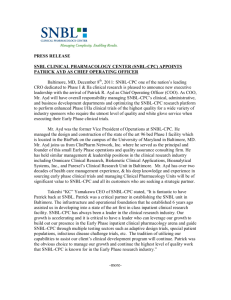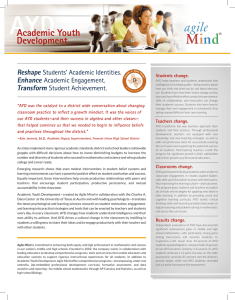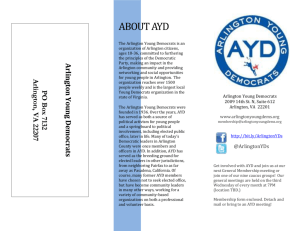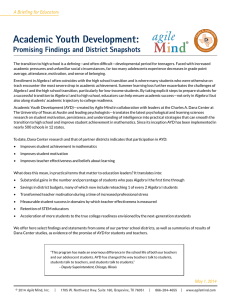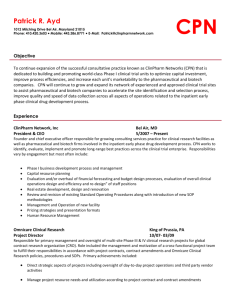Summary of Results From the 2008 Evaluation Conducted on Academic Youth Development:
advertisement
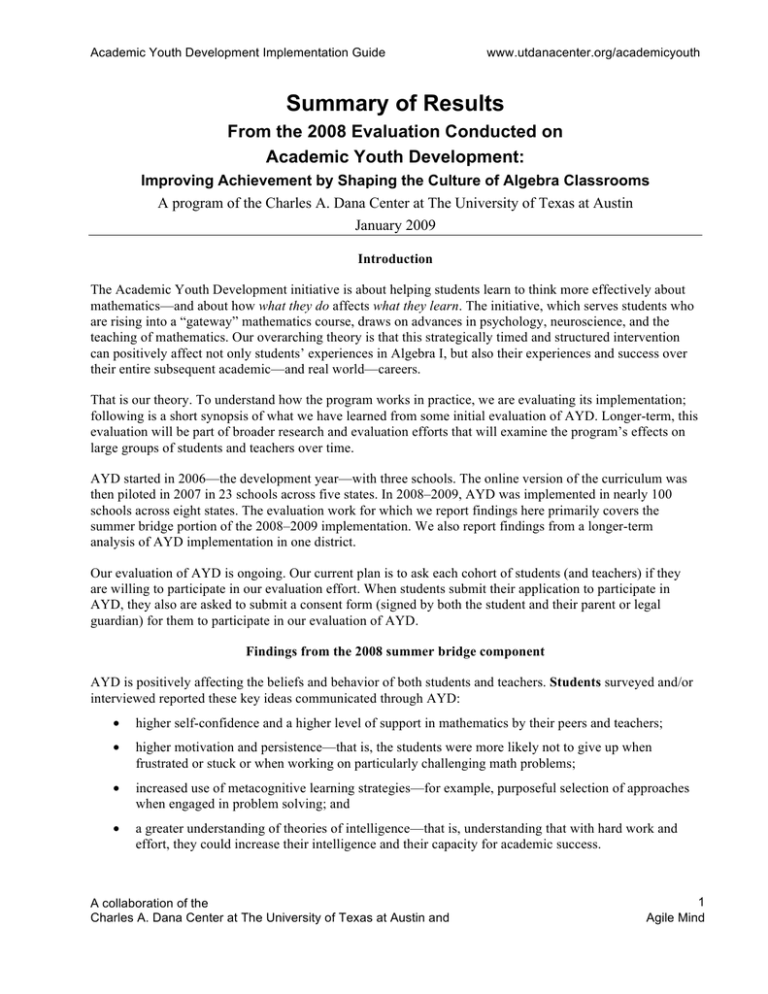
Academic Youth Development Implementation Guide www.utdanacenter.org/academicyouth Summary of Results From the 2008 Evaluation Conducted on Academic Youth Development: Improving Achievement by Shaping the Culture of Algebra Classrooms A program of the Charles A. Dana Center at The University of Texas at Austin January 2009 Introduction The Academic Youth Development initiative is about helping students learn to think more effectively about mathematics—and about how what they do affects what they learn. The initiative, which serves students who are rising into a “gateway” mathematics course, draws on advances in psychology, neuroscience, and the teaching of mathematics. Our overarching theory is that this strategically timed and structured intervention can positively affect not only students’ experiences in Algebra I, but also their experiences and success over their entire subsequent academic—and real world—careers. That is our theory. To understand how the program works in practice, we are evaluating its implementation; following is a short synopsis of what we have learned from some initial evaluation of AYD. Longer-term, this evaluation will be part of broader research and evaluation efforts that will examine the program’s effects on large groups of students and teachers over time. AYD started in 2006—the development year—with three schools. The online version of the curriculum was then piloted in 2007 in 23 schools across five states. In 2008–2009, AYD was implemented in nearly 100 schools across eight states. The evaluation work for which we report findings here primarily covers the summer bridge portion of the 2008–2009 implementation. We also report findings from a longer-term analysis of AYD implementation in one district. Our evaluation of AYD is ongoing. Our current plan is to ask each cohort of students (and teachers) if they are willing to participate in our evaluation effort. When students submit their application to participate in AYD, they also are asked to submit a consent form (signed by both the student and their parent or legal guardian) for them to participate in our evaluation of AYD. Findings from the 2008 summer bridge component AYD is positively affecting the beliefs and behavior of both students and teachers. Students surveyed and/or interviewed reported these key ideas communicated through AYD: • higher self-confidence and a higher level of support in mathematics by their peers and teachers; • higher motivation and persistence—that is, the students were more likely not to give up when frustrated or stuck or when working on particularly challenging math problems; • increased use of metacognitive learning strategies—for example, purposeful selection of approaches when engaged in problem solving; and • a greater understanding of theories of intelligence—that is, understanding that with hard work and effort, they could increase their intelligence and their capacity for academic success. A collaboration of the Charles A. Dana Center at The University of Texas at Austin and 1 Agile Mind Academic Youth Development Implementation Guide www.utdanacenter.org/academicyouth Participating teachers who were interviewed pointed toward changes in classroom culture. That is, a majority of teachers talked about the emergence of a culture of respectful engagement (a key goal of the AYD initiative). They reported: • students taking more responsibility for their role in creating and sustaining a positive academic learning environment; • better student-to-student communication—for example, sharing, talking through ideas, solving problems together; • higher levels of student engagement—for example, almost all students, even those who previously were disengaged in school, participated more in class; • increased willingness of students to work with one another; and • increased willingness of students to encourage and support one another in their learning. Teachers also reported that students who had been challenging or disengaged at the start of the program became, as one teacher put it, “a delight to work with” and many became leaders during the course of the summer. Teachers also observed strong friendships developing among students. Findings from longer-term analysis of AYD implementation in one district We also conducted a study of one school district that has participated in AYD since the program launched— meaning that three cohorts of students from this district have gone through the program. Of those students who participated in AYD prior to 2008, fewer repeated Algebra I than did peers who did not participate in AYD. Results from this analysis are encouraging, but they must be interpreted with the following three cautions in mind: First, the district codeveloped the AYD program, so its understanding and implementation of the program may be deeper and richer than those of other districts. Second, in the district’s first two years of implementation, AYD was not fully formed; thus, results from those years may not be comparable to results from the third year. Finally the sample size is small and may not be representative of all AYD districts. Specifically, results from this analysis show that a much smaller percentage of 2007–08 AYD students repeated Algebra I during their sophomore year than did non-AYD students enrolled in both single- and double-period Algebra I (9% of AYD students repeated Algebra I, compared to 24% of students in singleperiod algebra and 40.1% of students in double-period algebra). Thus, a higher percentage of AYD students moved on to geometry than did their non-AYD peers. Summary of evaluation findings The results of this internal evaluation of AYD are encouraging. The analyses show statistically significant and positive changes in AYD students’ beliefs and attitudes about learning mathematics and being an active and engaged student. After participating in AYD, students are more motivated and engaged in school and better able to use strategies that facilitate academic success. The students themselves report feeling more positively supported by their peers and teachers. Teachers also report positive changes in student behavior and learning. Additionally, data from the study of AYD in one district suggest that participation in AYD increases students’ success rate in Algebra I compared with the success rate of nonparticipating students. For more information about the Academic Youth Development program, go to www.utdanacenter.org/academicyouth. A collaboration of the Charles A. Dana Center at The University of Texas at Austin and 2 Agile Mind

